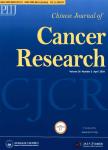SITE SPECIFIC CANCER INDUCTION BY INTRA-ESOPHA-GEAL COTTON NODE RETENTION AND CARCINOGEN LADEN DRINKING WATER
SITE SPECIFIC CANCER INDUCTION BY INTRAESOPHAGEAL COTTON NODE RETENTION AND CARCINOGENLADEN DRINKING WATER作者机构:Department of Pathology Shanghai Medical University Shanghai 200032 China Department of Pathology Okayama University Medical School 700 Japan
出 版 物:《Chinese Journal of Cancer Research》 (中国癌症研究(英文版))
年 卷 期:1998年第10卷第2期
页 面:36-39页
核心收录:
学科分类:1002[医学-临床医学] 100214[医学-肿瘤学] 10[医学]
基 金:the Education Committee of China Japan-China Medical Association, the Japan Society for the Promotion of Science Japan-China Peace and Friendship Association
主 题:Artificial restriction Esophageal carcinoma Chemically induced Rat
摘 要:Objective: To reveal the relationship between the restriction of esophagus and the esophageal carcinogenesis. Methods: Male Wistar rats weighing 200±20g (N=50) observed as experimental animals. Using carcinogen NethylNbutylnitrosamine (EBN), or NnitrosomethylNpropylamine (MPN), esophageal carcinogenesis was induced. In some rats, a cotton node was detained in the thoracic segment of the esophageal lumen to make artificial restriction. The rats were divided into 6 groups. Group EC or MC were those treated with the artificial restriction and EBN, or MPN. Group E, M or C included those treated only with EBN, MPN, or cotton node. Group U was untreated control. The rats were sacrificed, and the esophagus from the 6 groups of rats were compared. Results: On naked eye examination, the esophageal lesion was the most in EC group, followed by MC group. About 70% of the lesions were within 3mm from the thread node. The E or M group only had a few lesions. There was no observable lesion in the C and U groups. Histological examination found that the hyperplasia, hyperkeratosis, papilloma, and dysplasia were significantly more in EC and MC groups than E and M groups. Severe dysplasia and carcinoma in situ were only noticed in the EC and MC groups. Conclusion: It is suggested that the artificial restriction promotes the esophageal carcinogenesis. The effect is related with increased contact with carcinogen and injury at the area of the restriction.



